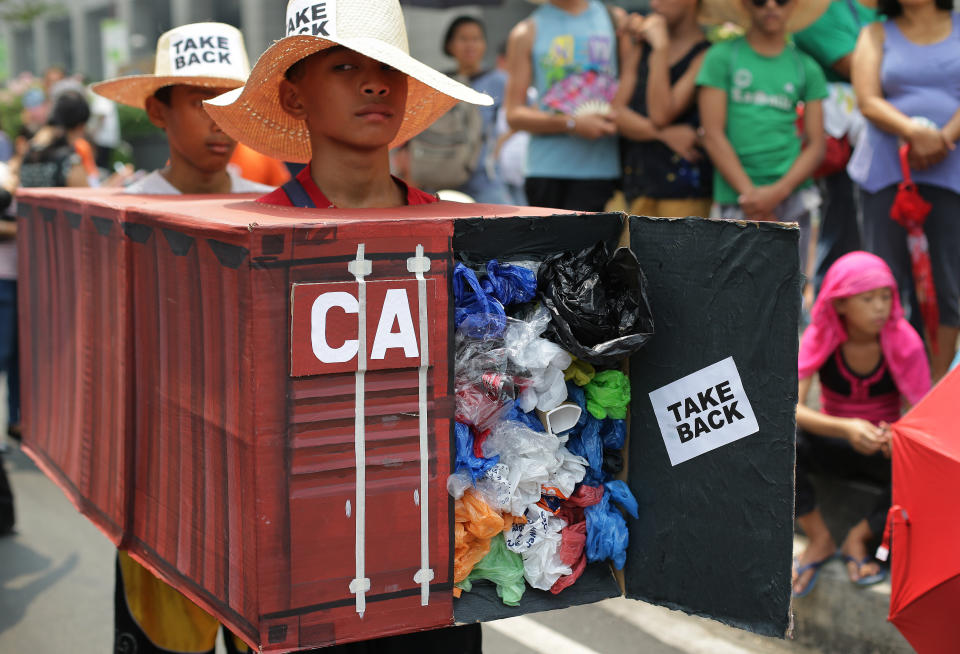Which countries are dealing with Canadian garbage? Not just the Philippines

After a very public debacle with the Philippines, Canada is in hot water again over plastic left in another Asian nation.
This week, officials in Malaysia opened a shipping container containing now infamous Canadian trash. Plastic bags spilled out from major Canadian brands, the CBC reported.
"I think you need to take back your rubbish," the Malaysian Environment Minister Yeo Bee Yin told CBC News at a port outside Kuala Lumpur.
Officials wouldn’t say where in Canada the recycling came from, but they did say they would be returning it. The plastic is too contaminated to be brought into the country for processing, they told the CBC.
The recycling dump in Malaysia comes at the heels of major controversy in the Philippines, after the country’s president claimed he would declare war if Canada didn’t take their trash home.
Canadian garbage in the Philippines
Something is rotten in the Philippines, and Canada is entirely to blame, according to the country’s president.
Filipino president Rodrigo Duterte made threats against Canada concerning an issue that’s been plaguing them since 2013 —2,500 tons of trash dumped by a Canadian company at a port near Manila.
In 2013 and 2014, more than 100 shipping containers were sent to the port, labelled as plastics meant for recycling. But after an investigation by Filipino customs officials, the containers were found to hold garbage with items like dirty diapers and spoiled foodstuffs.
Why is the garbage there?
The shipping containers were wrongly labeled as ‘plastics’ when they were really pure garbage, causing them to be shipped near a recycling facility near Manila.
The improper labeling led the garbage to sit for years, as the recycling facility can’t process the trash dumped.
How long has Canada known about the garbage?
The rotting Canadian trash is a well-known issue in the Philippines and has led to protests in the country, with activist pleading with Prime Minister Trudeau to finally take out the garbage.
In January, the EcoWaste Coalition wrote a letter to Trudeau asking him to address the trash, as he had previously promised to get rid of it in 2017.
The letter noted that South Korea took back 50 containers of garbage that were dumped by accident in 2018.
“The stark contrast between South Korea’s actions and Canada’s indifference to its dumped waste has captured public attention and stoked anger at what is viewed as both disrespectful and illegal conduct by Canada,” the letter stated.

In 2014, the Filipino government suggested the Basel Convention, which prevents developed countries from shipping waste to developing nations, could be used to send the containers back to Canada.
While on a visit to Manila in 2015, Trudeau was asked about the situation and he said a “solution” was in the works.
Ottawa has been trying for years to convince the country to dispose of the garbage in the Philippines, to no avail. A Filipino court ruled in 2016 that the trash must be returned to Canada, creating a standoff.
When is the garbage returning?
The garbage issue found a larger international profile after Filipino president Rodrigo Duterte made comments about the trash that captured global attention.

"I'll give a warning to Canada maybe next week that they better pull that thing out or I will set sail," said Duterte in a video broadcast through his office.
"I will declare war against them. I will advise Canada that your garbage is on the way. Prepare a grand reception. Eat it if you want to."
"Your garbage is coming home,” he said.
Within 48 hours Environmental Minister Catherine McKenna announced that in the coming weeks, the government will be looking for a solution to finally get rid of the tonnes of garbage.
At a press conference on April 24, McKenna said threats from Duterte don’t help the situation. "We also need to do this in a positive way. That's certainly the way we're going forward. It has been a file that's been going for a while. We're very close to finding a solution,” she said to media.
The situation continued to escalate in early May, with Filipino authorities stating that Canada has missed a May 15 deadline to take the trash back. They recalled their ambassador to Canada as a result.
McKenna later announced that a contract had been signed to bring the waste back, and Metro Vancouver will burn it.


